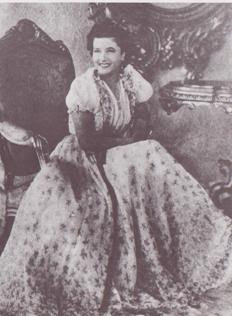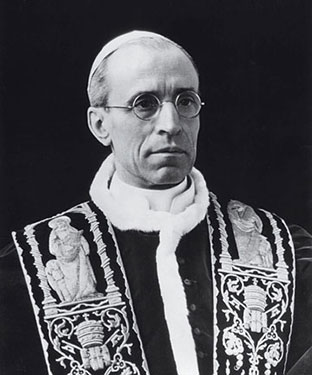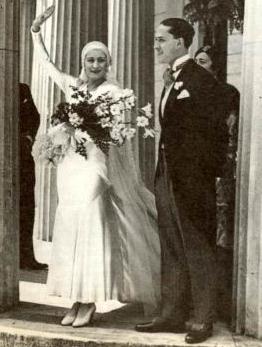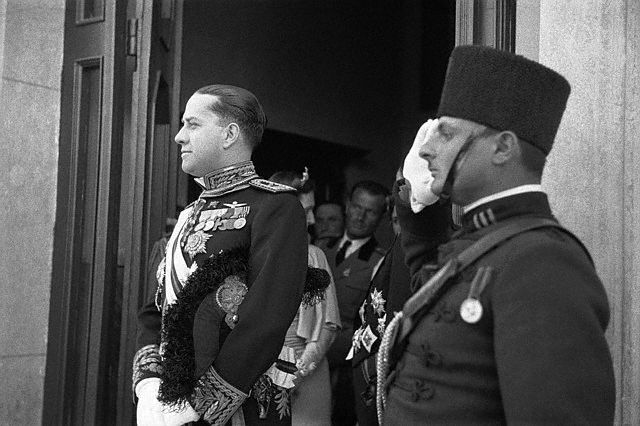[i]. Edda & Galeazzo Ciano were deeply divided over Italian relations with Germany. In early August 1942 the couple had a violent argument, with Edda attacking him for his attitude towards the Germans, but concerned for his well-being in a world where Germany appeared triumphant – by now the Germans ruled large swathes of Russia, & occupied most of Europe from France to the Baltic. Their forces were rampaging across northern Africa, while the Japanese fought the Allies in the Pacific
Edda was also concerned by her father’s infatuation with his mistress. Mussolini had become enamoured of Claretta Petacci, a woman two years younger than Edda. They first met by chance in 1933 in Ostia. Three days later Mussolini invited her to visit him at the Palazzo Venezia[ii], in the little room he kept for naps (and lovers). By 1936 Petacci was installed in an apartment in the Palazzo Venezia, her husband being sent off to Tokyo as an attaché.
 |
| Claretta Petacci |
It did not take long for Roman society to notice the Duce’s ‘vulgar’ mistress, who wore a fur coat to the opera, combined with heavy make-up (definitely not acceptable by Fascist standards). Claretta’s influence over Mussolini was not lessened by his involvement with another young woman, Elena Curti, a 19 year old typist. Rachele appears to have known nothing about Claretta until 1943, after Mussolini’s arrest[iii].
Claretta’s exceptionally corrupt brother Marcello upset the Fascist prominente, more than Claretta upset the society matrons. In mid-April 1942 Mussolini’s sister Edvige called on Ciano to complain about the corruption of the Petacci clan, claiming she had proof. Edda had already told Galeazzo that she was going to discuss the matter with her father. By the end of the month the Prefect of Venice was informing Ciano of Petacci’s scandalous behaviour & the suppression of reports on the incident by Buffarini-Guidi[iv], who was also funding Claretta to the tune of 200,000 lira a month. Ciano did not feel in a strong enough position to raise the Petacci problems with Mussolini himself; although by the end of June Ciano had taken action to stop gold smuggling via the diplomatic bags – Petacci & his associates were heavily involved in the trade.[v]
In 1940 Claretta’s sister, Maria used the Mussolini connection, attempting to launch herself as a singer, under the name Myriam di San Servolo, despite a thin voice. She then moved into risqué films. In June 1942 Maria married a count, in a wedding that Ciano noted was talked of as having ’expensive & fantastic gifts, forests of flowers, and Lucullan banquets’. A friend of Ciano’s told him that Mussolini had taken more interest in Maria’s wedding, than in the weddings of his own children. At the end of the month Ciano was informed that the Carabinieri had declined to take action against a criminal, as he was a lover of Maria Petacci.[vi].
In August 1942 the Italian government was informed by Otto von Bismark, an attaché at the German embassy, of the fate of Europe’s Jews; when he visited the Foreign Ministry to present a demand that the Italians hand over the Jews in Italian occupied Croatia. Mussolini agreed, but when the army refused to comply with the German order Mussolini did nothing to ensure that it was carried out. Mussolini was not an extreme anti-Semite, but he was totally under Hitler’s influence by now, hypnotised & unable to act against the Fuhrer’s will [vii].
 |
| Claretta |
In November 1942 Edda presented Mussolii with irrefutable proof of the criminal behaviour of Claretta’s family. An allegedly shocked Mussolini promised to get rid of Claretta. There was little change – Mussolini did send Claretta away, but allowed her to return after 3 days. Not long after the meeting with her father Edda, rightly sceptical about her father’s promises, travelled to Sicily to continue her nursing career. The Petacci family then declared war on Edda & rumours of Ciano’s treason began to circulate[viii].
By the end of the year the Germans were facing the catastrophe, of Hitler’s making, that was Stalingrad. While in Europe the Jews were facing ever-increasing deprivation & ever increasing numbers were pushed into the ‘shower rooms’ at Auschwitz. In early January 1943 the German ambassador von Mackesen visited Ciano to explain the German position vis a vis the Jews. Later in the month Roosevelt announced that the Allies would only accept unconditional surrender – a blow for Ciano and his allies, who were hoping to extract Italy from the war crippling their country.
Mussolini was aware of Ciano’s flirting with the nascent opposition, one of his reasons for dismissing Ciano in February. Mussolini took the Foreign Affairs portfolio for himself, as part of a cabinet reshuffle. Dr Petacci then chose this moment to reveal his more than somewhat superficial plan to win the war, including attacks by Spain, Turkey & China on the Allies. Edda blamed the Petacci’s for Ciano’s downfall[ix].
 |
| Pope Pius XII |
Offered a choice of other jobs Ciano elected to become the Ambassador to the Holy See. The family meeting with the Pope was a nightmare. Ciano had to drive the five of them to the Vatican himself in a tiny Fiat 500, as the family chauffeur had gone missing. Ciano was in full ambassadorial costume, while Edda was in evening dress & Raimonda was wearing her communion robe. During the meeting Marzio struggled with the Pope over possession of the Pope’s gold telephone. The Pope cut the meeting short[x].
In March 1943 the Italian army refused to hand over French Jews to the Germans, from the Italian occupied zone of France. During the spring & early summer Ciano was occasionally assisting Jews to escape, using his Vatican contacts to have false papers issued; though these actions may have been meant as an alibi when the war was finally lost.. Edda was still in Sicily in May when her father sent her 50,000 lira to distribute amongst the poor. By the time she returned to Rome in June Edda was exhausted & her German sympathies had evaporated.
The king was being pressed to take action. On the 12th May German & Italian forces surrendered in Africa & the Germans were busy building up their forces in Italy itself. Meanwhile Ciano had been in contact with the British in an attempt to take Italy out of a war that was obviously no longer winnable (in the eyes of most, with the notable exceptions of Hitler & Mussolini)[xi].
The Allied landings in Sicily, cutting up into the soft underbelly of the Axis, began on the night of 9th July, facing stiff opposition from the German troops Hitler was already in possession of intelligence reports showing that Mussolini was to be replaced by the Italian Chief of Staff Badoglio in a coup d’État, by the 20th July, the day after his meeting with Mussolini at Feltre. The king had agreed to Mussolini’s arrest, in principle on the 14th.
Dino Grandi, former Foreign Minister & former Ambassador to Britain, proposed a motion in the Fascist Council meeting called for the 24th, where a majority of the council, including Ciano, voted for the king to replace Mussolini as commander of the armed forces. A stunned Mussolini left the chamber without taking any action. He was arrested on the king’s order the following day after leaving an audience with the king. Mussolini was spirited away & Badoglio took over the running of the country[xii].
The scene was set for the tragedy to come.
[i] Diary 1937-1943 by Galeazzo Ciano 2002, Enigma Books, Mussolini’s Shadow by Ray Moseley 1999, Yale University Press
[ii] Prime Minister’s office
[iii] Mussolini by RJB Bosworth 2002, Arnold
[iv] Under-secretary of the Interior Ministry
[v] Diary – Ciano, Mussolini’s Shadow - Moseley
[vi] Mussolini – Bosworth, Diary - Ciano
[vii] The Destruction of the European Jews by Raoul Hilberg, 1985 Holmes & Meier, The Italians & the Holocaust by Susan Zucotti, 1987 Basic Books, Mussolini – Bosworth, Mussolini’s Shadow – Moseley, Mussolini - Farrell
[viii] My Truth by Edda Mussolini Ciano 1977, Wiedenfeld & Nicholson, Mussolini: A New Life by Nicholas Farrell, 2004, Phoenix, Mussolini’s Shadow - Moseley
[ix] Mussolini’s Shadow – Moseley, Mussolini - Bosworth
[x] My Truth - Ciano
[xi] Mussolini’s Shadow – Moseley, Mussolini - Bosworth
[xii] Mussolini’s Shadow – Moseley, Mussolini – Farrell, Hitler 1936-1945 Nemesis by Ian Kershaw Penguin 2001









